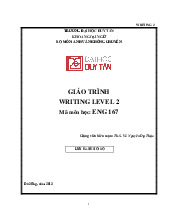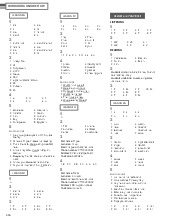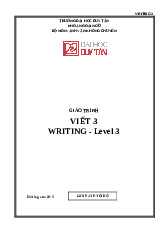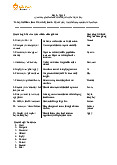



















Preview text:
TABLE OF CONTENT
INTRODUCTION…………………………………………………………………….1
PART I: READ A TEXT ALOUD..............................................................................3
Lesson 1: Introduction to Toeic Speaking Test, Part 1, and English Sound………….3
Lesson 2: Some common Troublesome Sounds, Word Stress and Intonation..............9
Lesson 3: Practice for Part 1..........................................................................................15
PART II: DESCRIBE A PICTURE............................................................................20
Lesson 4: Introduction to Part 2 and Picture Types ......................................................20
Lesson 5: How to describe a picture..............................................................................27
Lesson 6: Common expressions used to introduce a picture & Practice for Part 2.......33
PART III: RESPOND TO QUESTIONS..................................................................39
Lesson 7: Introduction to Part 3 and Question Types....................................................39
Lesson 8: Typical Topics for Part 3...............................................................................47
Lesson 9: Practice for Responding To Questions..........................................................50
PART IV: RESPOND TO QUESTIONS USING INFORMATION PROVIDED
………………………………………………………………………………………….52
Lesson 10: Introduction to Part 4 and some common Text Types.................................52
Lesson 11: Tips and Tasks for Answering Effectively..................................................58
Lesson 12: Practice for Part 4........................................................................................64
Lesson 13: Model test 1………………………………………………………………...71
Lesson 14: Model test 2……………………………………………………………….. 83
Reference……………………………………………………………………………….94 0
INTRODUCTION TO TOEIC 4 SKILLS TEST
The Test of English for International Communication, TOEIC®,is a standard and objective
assessment for English language proficiency in the workplace. The TOEIC®is the most used
test for Business English with more than 7 million worldwide test-takers each year. The
TOEIC®is recognized as proof of a person’s English language competence by businesses,
universities, technical colleges and business schools, when considering potential candidates
for admission to their organizations. In countries such as the United Kingdom, the TOEIC®
is a requirement for Visa applications.The TOEIC® 4 Skills testoffers a common standard of
measurement for listening, reading, writing, and speaking skills. Test Format
• Non-incremental placement test (no pass-or-fail system)
• Paper and pencil (Listening & Reading)
• Online test (Speaking &Writing)
• Administered in authorized TOEIC® test centers
• Individual test sittings available by appointment Language Level
A1-C1 in accordance with the Common European Frame of Reference Usage
Evaluation and certification of English language skills are usedat a specific point in time for
students, graduates, employees, job applicants and professionals, who may require evidence
of their language skills for their studies or jobs. The test can also be used as an aid to monitor
the learning progress of individual’s participating in language training programs. Structure
Listening: 100 multiple choice questions in 45 min.
Reading: 100 multiple choice questions in 75 min.
Speaking: 11 tasks (6 types of questions) in 20 min.
Writing: 8 tasks (3 types of questions) in 60 min. Test Length
200 min. test duration plus a break of 30 min. between Listening & Reading, Speaking & Writing Results
• Score reports for Listening & Reading and Speaking & Writing 1
• Individual analysis of strengths and weaknesses
• Correlation table with CEFR* mapping and Can-Do-Statements
• Certificate for all four skills (optional)
• Score evaluation within 15 business days, excl. postal time
INTRODUCTION TO TOEIC SPEAKING
The TOEIC Speaking test certification offers an international standard for measuring and
determining language skills of non-native speakers in the daily life and global workplace. The
tests use common everyday vocabulary, phrases and key expressions that reflect real-world
tasks and provide information that enables score users to fairly and easily:
Save time and resources by knowing immediately in the recruitment process who has
effectively in the international workplace
Help businesses train, develop and promote the most qualified employees who can
interact effectively with colleagues and clients around the world
Help Language schools give added value to their training and development programmes
Give job seekers and employees a competitive advantage
Enable universities to better prepare students for today’s international workplace
Help Individuals enhance their value and succeed in the global job market
In addition, Governments use the TOEIC Listening and Reading test and the TOEIC
Speaking and Writing tests as a valid accreditation to help them make vital decisions for
immigration and naturalization purposes.
THE TEXT BOOK ‘TOEIC SPEAKING LEVEL 1’
This text book is designed to give students basic knowledge about the first 4 parts in Toeic
Speaking Text and then give students lots of practice to improve their skills. The book
includes 14 lessons with lots of theories and practice. Among them, the first 12 lessons
provide students with lots of useful languages and practice to help them improve their
speaking skills in the first 4 parts in Toeic Speaking; the last 2 lessons are the 2 model tests
for students in their final test for Speaking Level 1. 2
PART I: READ A TEXT ALOUD
LESSON 1: INTRODUCTION TO TOEIC SPEAKING, PART 1 & ENGLISH SOUND
I. INTRODUCTION TO TOEIC SPEAKING TEST:
Speaking Test Format
The test is designed to provide information about the Speaking language ability of speakers
across a range of English proficiency and the time to deal with all the tasks in the Toeic
Speaking Test is approximately 20 minutes. Duration 11 Tasks Evaluation Criteria Tasks 1–2 Pronunciation Read a text aloud Intonation and stress Tasks 3 All of the above, plus Grammar Describe a picture Vocabulary Cohesion Tasks 4-6 All of the above, plus Respond to questions Relevance of content Completeness of content Tasks 7-9 Respond to questions using All of the above information provided Tasks 10 All of the above Propose a solution Tasks 11 All of the above Express an opinion 3
II. INTRODUCTION TO PART 1- READ A TEXT ALOUD:
Possible topics may include:
» Advertisements, announcements, and news broadcasts
» Tour information, traffic reports, and weather reports
» Entertainment, health, housing, shopping, and travel QUICK GUIDE: Read a Text Aloud Definition
Questions 1 and 2 test your ability to pronounce words
clearly and speak English in a comprehensible way. You
will read a short text aloud, and your reading of the text will be recorded for scoring. Targeted Skills
In order to do well on Questions 1 and 2, you must be able to:
• pronounce common words correctly.
• use correct intonation when reading sentences.
• use correct stress on syllables and words. Text Types A good response will:
• reflect an accurate pronunciation of the words.
• contain smooth connections between words.
• contain accurate phrasing of groups of words and “chunks” of language.
• include correct stress for emphasis, new information, and contrast.
• include appropriate intonation to indicate the attitude or tone of the text. Things to Remember
1. Scan the entire text before reading so you have an idea of the content.
2. Read clearly and in a voice that can be easily heard.
3. Remember to pause for commas and periods.
4. Be sure to use intonation that matches the meaning of the sentences.
5. Be careful to pronounce the words correctly. 4
III. INTRODUCTION TO ENGLISH SOUND 1. VOWELS: - Short vowels - Long vowels - Dipthongs EXAMPLE [i:] be, eve, see, [i] it, kiss, tip, [e] let, tell, meal, read, system, busy bread, dead [ei] aim, wait, [æ] cat, apple, [a:] army, car, eight, weight, last, class father, calm [ai] ice, find, my, [au] out, about, [o] not, rock, style now, brown more, order [o:] saw,bought, [oi] oil, voice, [ou] go, note, law, thought noise, boy open 2. CONSONANTS 5 EXAMPLE III. Practice: 6
Identify the vowels and consonants in the following words and phrases 1. 2. 7 3. A. B. 1. have an open book 18. taking a break 2. paying the cashier 19. watering the plant 3. using a pay phone 20. weighing the luggage 4. using a public phone 21. working on the computer 5. performing outdoors 22. working on the farm
6. reaching to pick up the tools
23. sitting in alternate seats 7. picking some flowers 24. hanging on the wall 8. walking along the pier 25. hanging from the ceiling 9. pointing at the document 26. is at the intersection
10. pouring water for the customer 27. lined up on the shelf 11. using a projector 28. lying on the ground
12. putting fuel in the vehicle 29. overlook the water 13. raking the leaves 30. are partially shaded
14. reaching for something on the shelf 31. arranged in the patio 15. rearranging the furniture
32. piled up on the steps of the houses
16. looking at her reflection in the mirror 17. relaxing by the river
LESSON 2: SOME COMMON TROUBLESOME SOUNDS,
WORD STRESS AND INTONATION
I/ SOME COMMON TROUBLESOME SOUNDS: 1. short /i/ and / æ/ Ban can dan fan jan pan tan Bin kin din fin gin pin tin 2. /f/ and /v/ Fat fete fan life leaf fife Vat vet van live leave five 3. / / Asian closure collision decision diversion division Erosion immersion intrusion lesion measure pleasure 8 Television treasury version vision visual [t] vs[θ] [t] Tree Team Tie Taught [θ] Three Theme Thigh Thought [θ] vs [s] [s] Face Worse Gross Sick [θ] Faith Worth Growth Thick [l] vs [r] [l] Long Walking Light Late [r] Wrong Working Right Rate [b] vs [v] [b] Belly Boat Best Ban [v] Valley Vote Vest Van [p] vs [f] [p] Pan Peel Pork Pink [f] Fan Feel Fork Fine [e] vs [æ] [e] Men Left Said Pen [æ] Man Laughed Sad Pan [i] vs [i:] [i] Ship Fill Live Hill [i:] Sheep Feel Leave Heel [o:] vs [ou] [o:] Hall Saw Walk Called [ou] Hole Sew Woke Cold II. WORD STRESS
Stress is important in words and sentences. Knowing whether a syllable is stressed or
unstressed is an important part of pronouncing a word correctly. For example, re-CORD and
REC-ord have two very different meanings, but they have the same spelling, record.
Correctly stressing words and phrases gives rhythm to a sentence, and it signals the
importance of some information.
» TIP 1 Learn stress in order to pronounce words correctly.
All words with more than one syllable have stressed and unstressed syllables. Knowing
which syllables are stressed will help you pronounce words correctly and convey the correct meaning.
In nouns and adjectives with two syllables, the stress usually falls on the first syllable. For
verbs with two syllables, the stress usually falls on the second syllable. Listen and read the words in the chart. 9
TASK 1 Look at the words and analyze the suffixes. Underline the syllables that you think are stressed.
Knowing prefixes (the small parts that come before the root of the word) can also help you
predict the stress pattern of a word. When the word is a verb or has more than two syllables,
the stress is usually on the second syllable of the word. Here are examples of some common prefixes.
TASK 2 Look at the words and analyze the prefixes. Underline the syllables that you think are stressed. 10 TASK 3 boldfaced
Read the sentences and notice the
words. Circle the boldfaced words that
are nouns, and underline the boldfaced words that are verbs. Then double-underline CJ the
>>TIP 2 Stress words in sentences to emphasize or contrast information.
Use stress within a sentence to show that certain information is new or important. You
can also use stress to contrast information.
A: Would you like some tea?
B: I ’d like some black (1) tea.
A: Sure, here you are.
B: Sorry, but this is green (2) tea. I asked fo r black (2) tea.
You should also use stress to give more emphasis to the words that naturally carry meaning in
sentences— the content words. Function words, or the words in a sentence that are used to
give grammatical structure, don’t usually receive as much stress unless the speaker wants to
give some sort of contrast or emphasis.
The employees are the ones to thank.
There’s really not a lot to about that. say
Finally, adverbs are frequently stressed to add emphasis.
We really don’t have much time.
I completely forgot the conference.
TASK 1. Underline the words that receive stress on the first syllable.
1. The correct numbers are 13 and 17, not 30 and 70.
2. We strongly suggest that you back up your computer files at the end of the day.
3. Our genealogists will conduct a very thorough search of your family tree.
4. On the new schedule, you will see that the bus departs on Tuesday at 1 p.m.
5. Your estimated wait time to speak to a representative is ten minutes.
6. The parking spaces are clearly marked “visitor.”
TASK 2 Read the sentences. Which boldfaced words do you think should be stressed? Underline your choices.
1. The real estate office in the is located house green on the left.
2. You will receive a credit card within ten days after receipt of your application.
3. The message said to phone their office between 9 and 5, Monday to Friday.
4. We are currently reviewing your request and will respond within 30 days. 5. turn down Please
the volume on the TV, not up. III. INTONATION: I/ Intonation: 11
Sentence intonation helps the listener understand the speaker’s meaning, in addition to
the speaker’s attitude or mood. The most common intonation patterns are rising-falling for
statements and information questions and rising for yes-no questions. 1. Falling tune :
» TIP 1: Use correct intonation for phrasing in statements.
Statements typically have falling intonation, meaning the speaker’s voice lowers slightly at the end of the sentence.
We’ve had a lot o f success with the new plan.
There are a multitude o f reasons for the problem.
She really hasn’t done much in her new position.
Within a sentence, speakers may use rising or higher intonation in different situations. When
giving a series of numbers or a list of three or more items, the speaker will often use rising
intonation to let the listener know there is more to come. The speaker will then usually use
falling intonation on the last item to indicate the list is complete.
The key points here are time, expense, and quality.
Hotel management, health care, accounting, and education are all good career options.
Our new number is 218-555-3675.
Speakers will also use rising or higher intonation when there are clauses in a statement
to show that more information is to come. Notice the underlined clauses, the boldfaced
signpost words used to introduce them, and how the clauses affect intonation. Because we don’
t have the reports yet , we can’t have the meeting.
We really wanted to leave at 5:00; however
, the plane was delayed.
I really wanted to go to the conference, until
I saw the huge entry fees. Although I usually enjoy mv job
, this past month has been tough.
» TIP 2: Use correct intonation for questions. -
Information questions usually start with the word Who, What, Where,
When, Why, or How. These types of questions have falling intonation at the end of the sentence.
What did you do last weekend? When do we need to be there?
Where is the meeting? How many people are coming? 12
Why didn’t he call? How much does it cost? - Questions with ‘or’
These have a falling tune at the end
Would you like coffee or tea?
Would you like coffee and milk or tea? -
Question tags have falling intonation at the end of the sentence.
She couldn’t cook, could she?
You weren’t early, were you? 2. Rising tune:
Yes-No questions usually start with some form of an auxiliary verb, such as do, have, can, or
be. These types of questions have an up intonation. Listen to the yes-no questions below and notice the intonation.
Do you want to join the call?
Have you seen the report? B – Practice:
TASK : Do these questions have rising or falling intonation? Write for rising intonation
or for falling intonation. Then listen to check your answers and practice. 1. What do you think?
2. If Friday is not a good day, can we meet on Saturday?
3. I’m sorry, could you repeat that, please?
4. We didn’t hear that. What did he say?
5. What did John bring to the party? 6. How can I help you today?
7. Is this your first day here?
8. Have you sent the latest market reports? 13
LESSON 3: PRACTICE FOR PART 1
TASK 1: In the following words, the final -s always makes a /s/ sound. Practice reading the words aloud Bats blocks cats fruits licks lights Mats plants sheets socks tacks trucks
Notice that all the words above end in either a /k/ sound or a /t/ sound in their singular form.
Most other plural words end in a /z/ sound. Now practice reading pronouncing plurals that end in /z/. Animals apples computers dogs eyes glasses Kisses oranges pencils pillowstables tires
Now, pronounce the plural words below. Some will end with a /s/ sound, and others will end with a /z/ sound. Babies boats books candles chairs desks signs Drawers jerks plumbers shirts shoes
TASK 2: Identify /s, z, iz / in the plural form of nouns in the following sentence. 1. I saw the birds fly away.
2. What time did the guests leave?
3. He broke his arms in the accident.
4. She sang the songs her father wrote.
5. Where does she park her cars at night?
6. I read the books very quickly. 7. The bags fell on the floor. 14 8. The shops will be closed.
9. When will the classes begin?
10. The boxes won’t be big enough.
TASK 3: Write the pronunciation of –ed, /t, d, Id/ ending after each of the following words and read them: Walked asked watched erased laughed smiled Worked washed ironed helped coughed ended hated Cooked touched needed kissed stopped advertised Rained snowed remembered shaved played waited begged enjoyed signed closed sneezed booked Reported dropped listened attempted wanted loved
TASK 4: Talk about the photographs Ex: studied all night listened to the radio :
He studied all night, didn’t he?
No, he didn’t. He listened to the radio. 1. 2. 3. 15 combed his hair cried a lot painted the room brushed it laughed a lot cleaned it .4. 5. 6. emptied his glass closed the door walked away filled it opened it waited a long time TASK 5
Read the sentences below. Which boldfaced words do you think should be stressed? Underline your choices.
1. The real estate office in the is located house green on the left.
2. You will receive a credit card within ten days after receipt of your application.
3. The message said to phone their office between 9 and 5, Monday to Friday.
4. We are currently reviewing your request and will respond within 30 days. 5. turn down Please
the volume on the TV, not up.
TASK 6: Identify the stress for the following words 16
TASK 7: Do these sentences have rising or falling intonation? A. B. C. 1. What is physical health? 2. What is mental health?
3. Do you think that you are a healthy person?
4. Do you eat healthy food? Name your favorite healthy food.
5. Do you eat junk food? Name your favorite junk food.
6. Is typical food of your country healthy?
7. Do you ever lose your appetite?
8. How much exercise should a person do?
9. Do you exercise often? What do you like the most?
10. How much sleep should people get? How about you? 17
Task 8: Read aloud the text: TEXT 1 TEXT 2 TEXT 3 TEXT 4
Good morning, it is my pleasure to welcome you to National Airlines Flight 2737 to New
York’s JohnF. Kennedy Airport. We will be taking off shortly. At this point, I need to ask you
to turn off all electronic devices and return your tray tables and seats to their upright positions. Thank you TEXT 5 18
Hello, and welcome to dog obedience class! I’m going to ask everyone to take at seat in the
semicircle of chairs in front of me. Please get your dog to sit, and do whatever you need to do
to keep him or her sitting. It isn’t easy to get your dog to obey in such an exciting
environment, but it’s important if you want your dog to listen to you at the park. TEXT 6
Good morning, students. In five minutes, we will begin the test. You will have one hour to
complete the first two essays. I will warn you when you have 5 minutes remaining and then
again when you have 1 minute left. When I call time, you must put your pencils down. You
will not be allowed to return this section. 19



